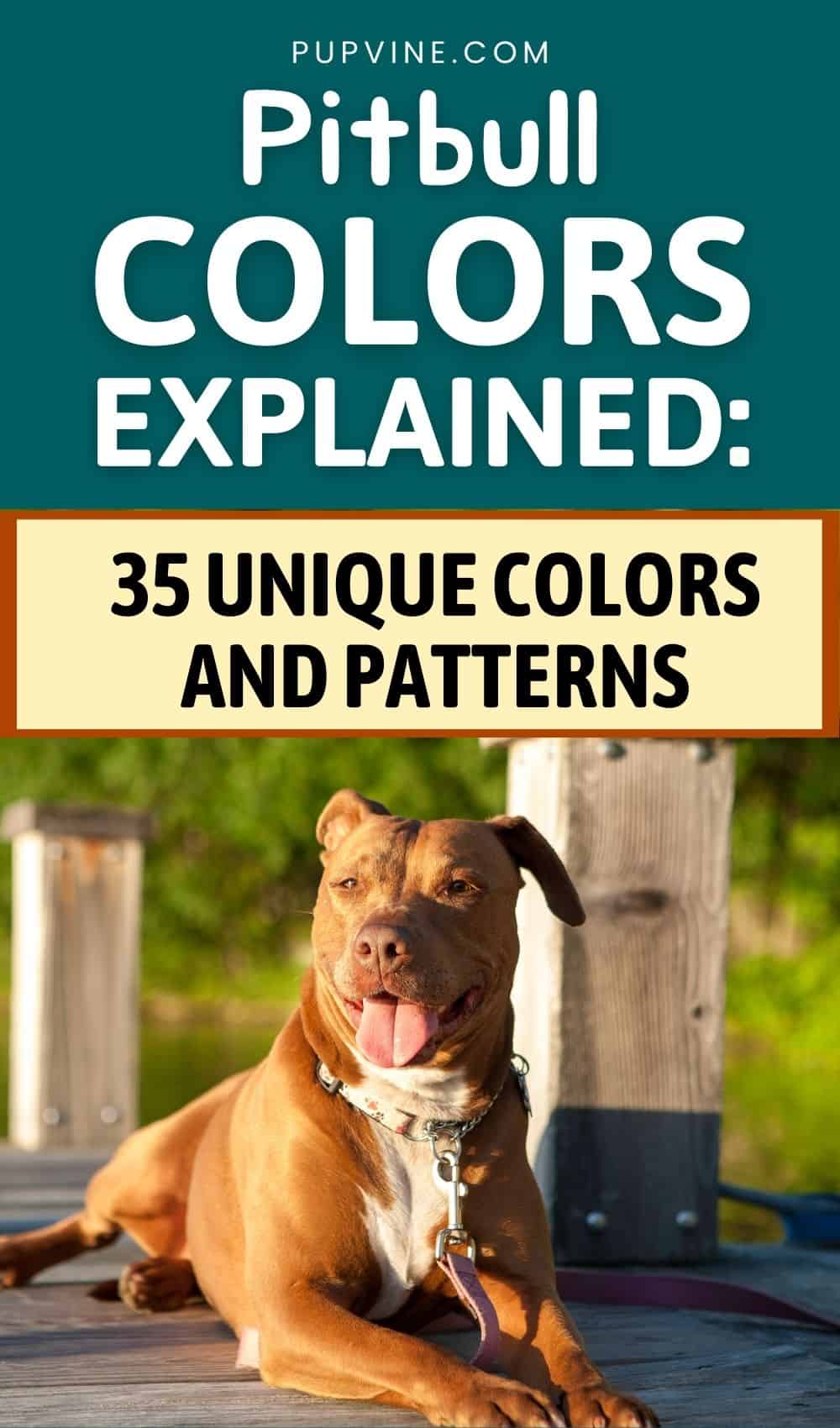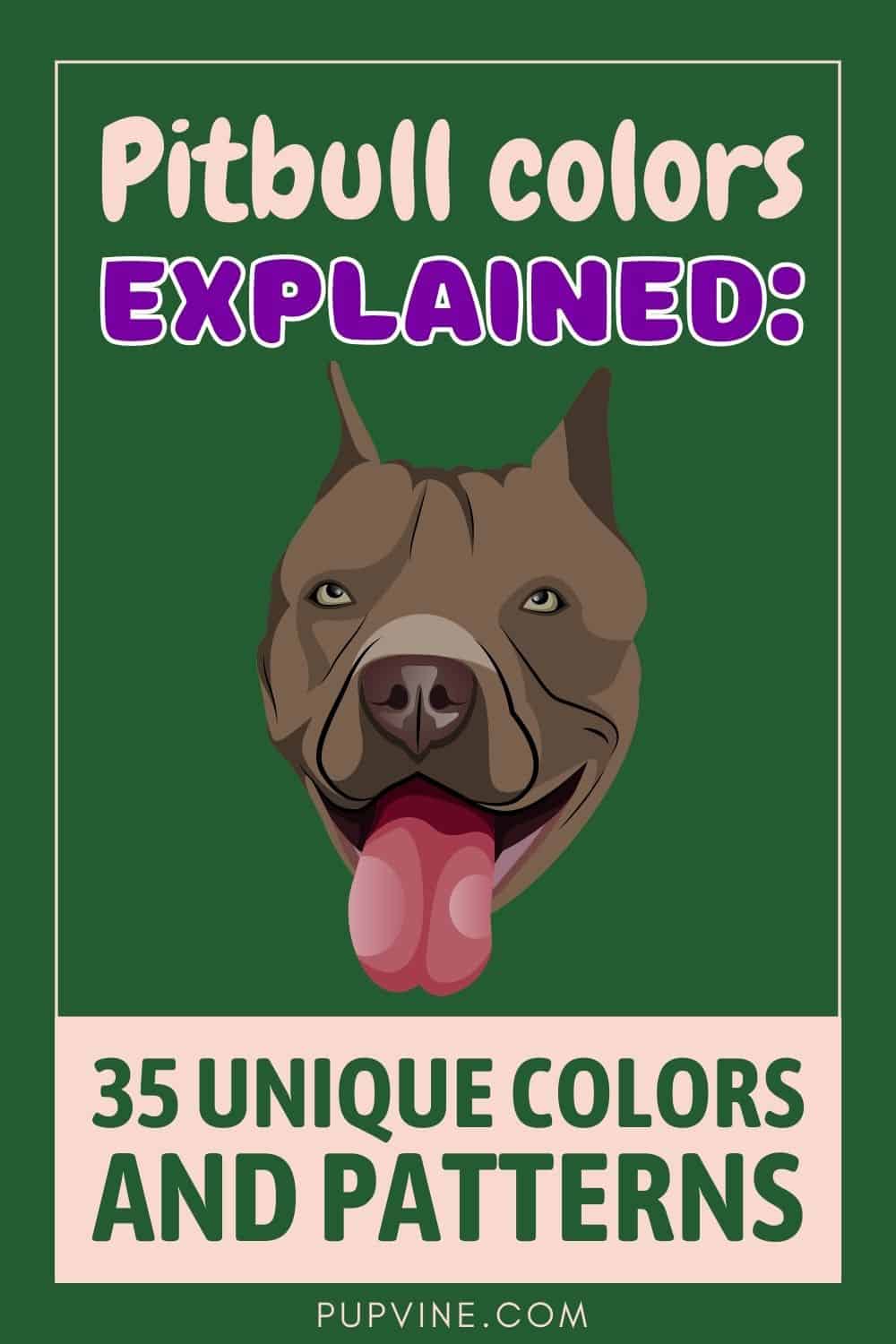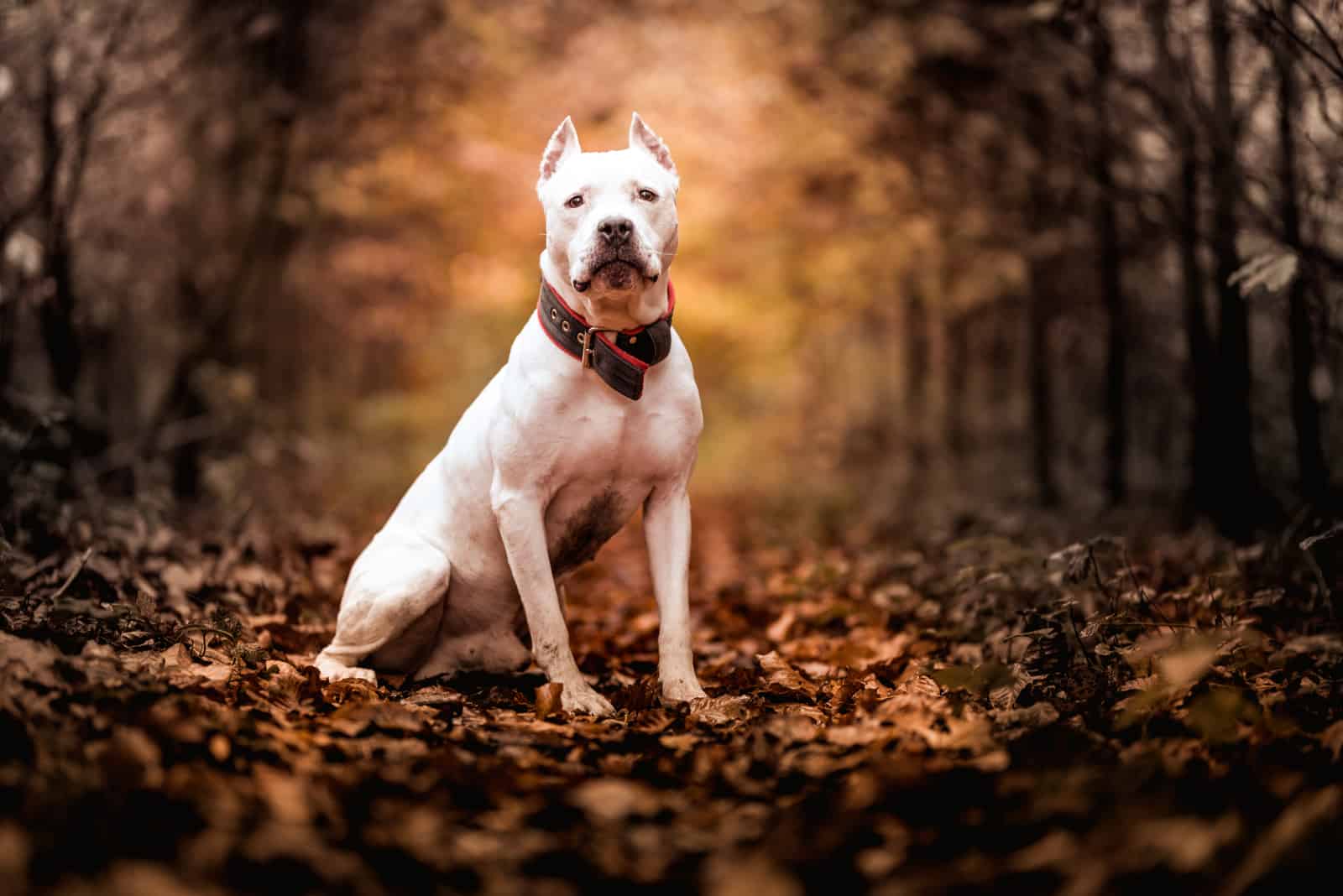Despite their undeserving bad reputation, Pitbulls are some of the most common guard dogs in the USA and Europe.
Other than the lovable personalities that make them more of a lapdog than fighting dogs, these dogs are loved because of their short fur that is easy to groom and take care of. Not to mention the huge number of colors they can come in!
Believe it or not, there are over 30 different Pitbull colors! This makes many people confuse these pups with other dog breeds, such as smaller Rottweilers!
It is uncertain when this breed was first created. However, it became famous in the 19th century, when it was used for bull- baiting.
This cruel sport was soon outlawed, but many gangs continued breeding these dogs for ring fights, especially in the 1990s. This is where their bad reputation originates from.
However, Pitbulls are great family pets and amazing nanny dogs that are loved by owners worldwide.
While there are several types of dogs that people consider to be various types of Pitbulls, only four dog breeds can truly be called that: the American Staffordshire Terrier, the Staffordshire Bull Terrier, the American Pitbull Terrier, and the American Bully.
There are also several well-known Pitbull bloodlines, such as the Colby Pitbull, the Gotti Pitbull, and the Razor Edge Pitbull.
All of these types of dogs have a short, medium to low-shedding coat that comes in plenty of colors and patterns that can make some people believe they aren’t purebred. While this is true for some Pitbull colors, others are simply rare and difficult to breed.
Some Pitbull crossbreeds can come in different coat colors that we won’t cover here. If you’re interested in Pitbull mixes and their unique appearances, here are some that might interest you:
• Golden Retriever Pitbull mix
• Basset Hound Pitbull mix
• Old English Bulldog Pitbull mix
Here’s what you need to know about 35 standard or rare Pitbull colors!
Do Pitbull Colors Matter?
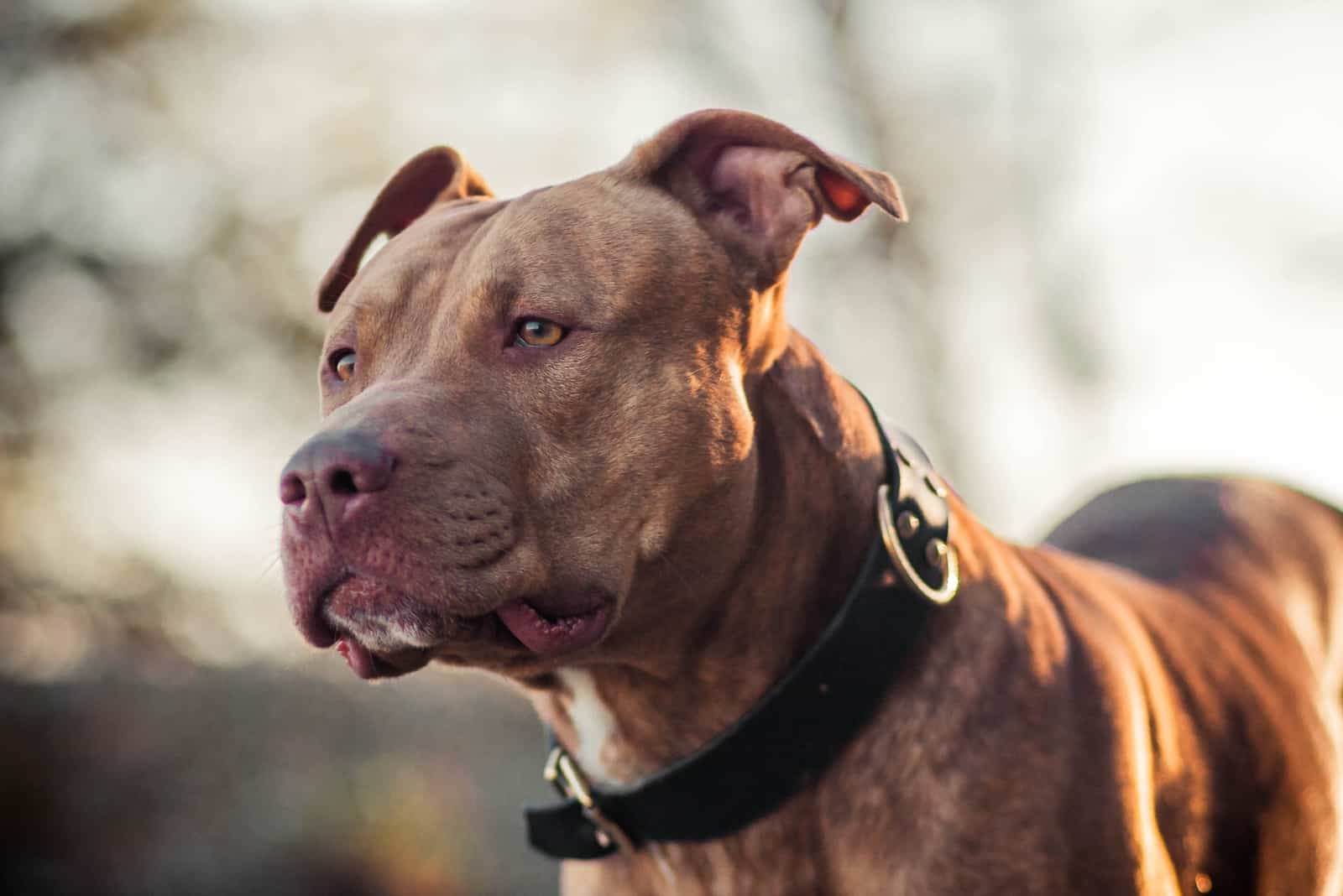
Typically, a dog’s coat color isn’t important – other than when it affects the Pitbull price. All dogs are equally beautiful, and their color doesn’t have much to do with their personality.
However, science proves that the Pitbull color does sometimes matter.
Some research studies have proved that there is indeed a connection between a dog’s coat color and its health and life expectancy.
For example, liver or chocolate-colored dogs are prone to numerous musculoskeletal disorders, skin and ear conditions, and cancers. This impacts their lifespan, and, on average, they live a bit shorter than dogs of other colors.
Also, white dogs seem to be more likely to have sight and hearing issues, including complete blindness and deafness. In fact, white dogs seem to be most likely to suffer from several different health problems.
Still, there is much exploring to be done to fully understand the impact of coat color on a dog’s health – and maybe even their personality.
Despite this, it is without a doubt that a canine’s color matters in some cases, especially health-wise.
Four Pitbull Breeds
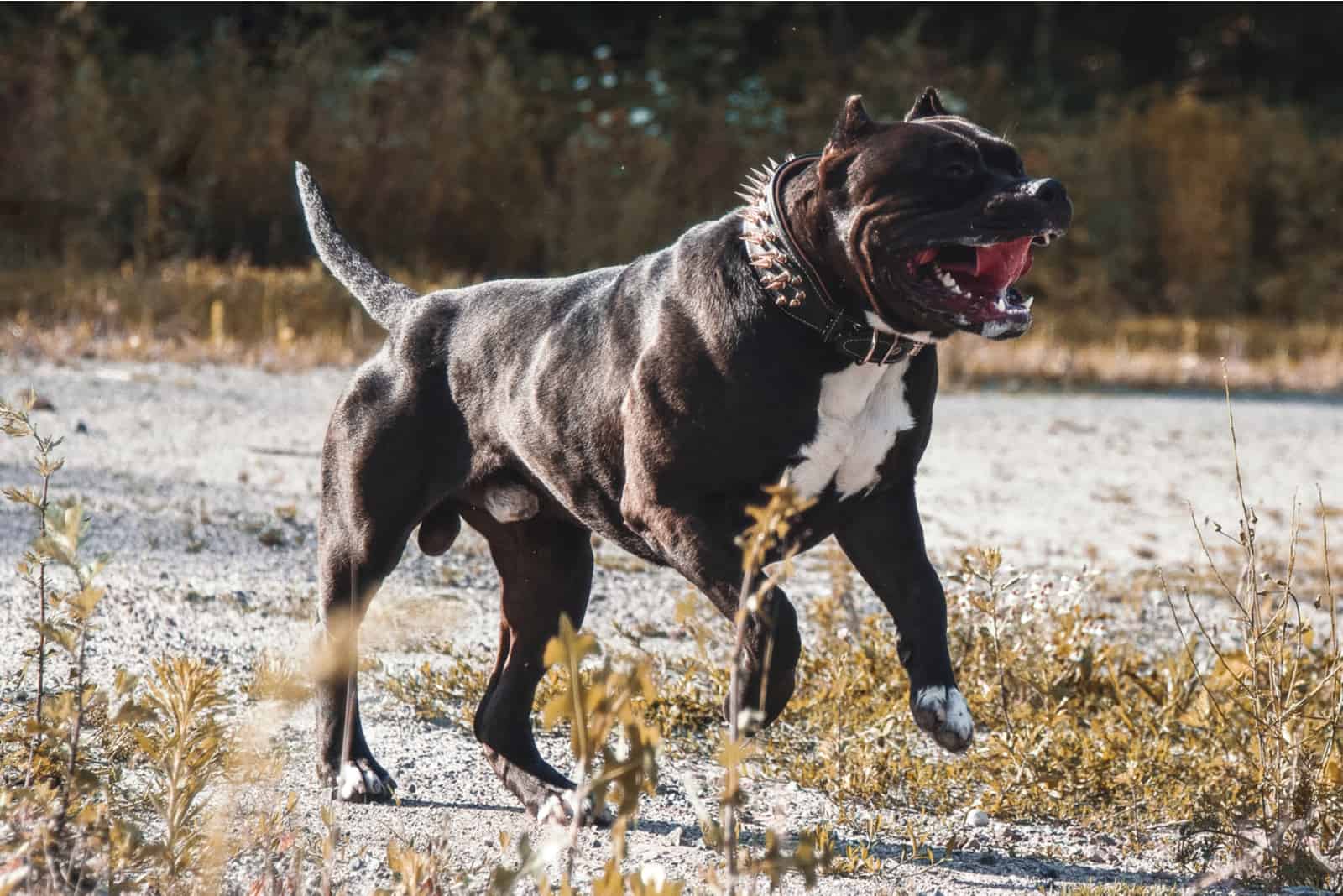
Before we continue talking about Pitbull colors, it’s important to note that there are four types of Pitbull. We’re talking about all of them – not just about the American Pitbull Terrier, which is usually the dog people think about when they hear about ‘Pitbulls.’
As mentioned above, Pitbull is just an umbrella term that people use to label breeds that are descendants of Terriers and Bulldogs. However, it doesn’t mean people are necessarily talking about American Pitbull Terriers.
Four dog breeds fall under the Pitbull label. They are:
American Pit Bull Terrier – A purebred dog that has existed for around 150 years. It’s important to note that these pups aren’t recognized by the American Kennel Club ( AKC ), but, ironically, the United Kennel Club ( UKC ) accepts APBTs as a unique breed.
Staffordshire Bull Terrier – This dog breed is recognized by both the AKC and UKC and is the most famous breed in the UK. They are the shortest Pitbull breed, as they are rarely taller than 7 inches.
American Staffordshire Terrier – These pups are commonly known as AmStaff. Both the AKC and UKC recognize them. This is the most decorated war dog. As a result, three US presidents kept them as pets in the White House.
American Bully – This is the most recent Pitbull breed, as it was only recognized by the UKC in 2013. It is a descendant of the American Pitbull Terrier, but they are much larger. Some breeders refer to them as XXL Pitbulls.
The colors we’ll talk about further refer to all four of these Pitbull breeds.
Colors of The Pitbull
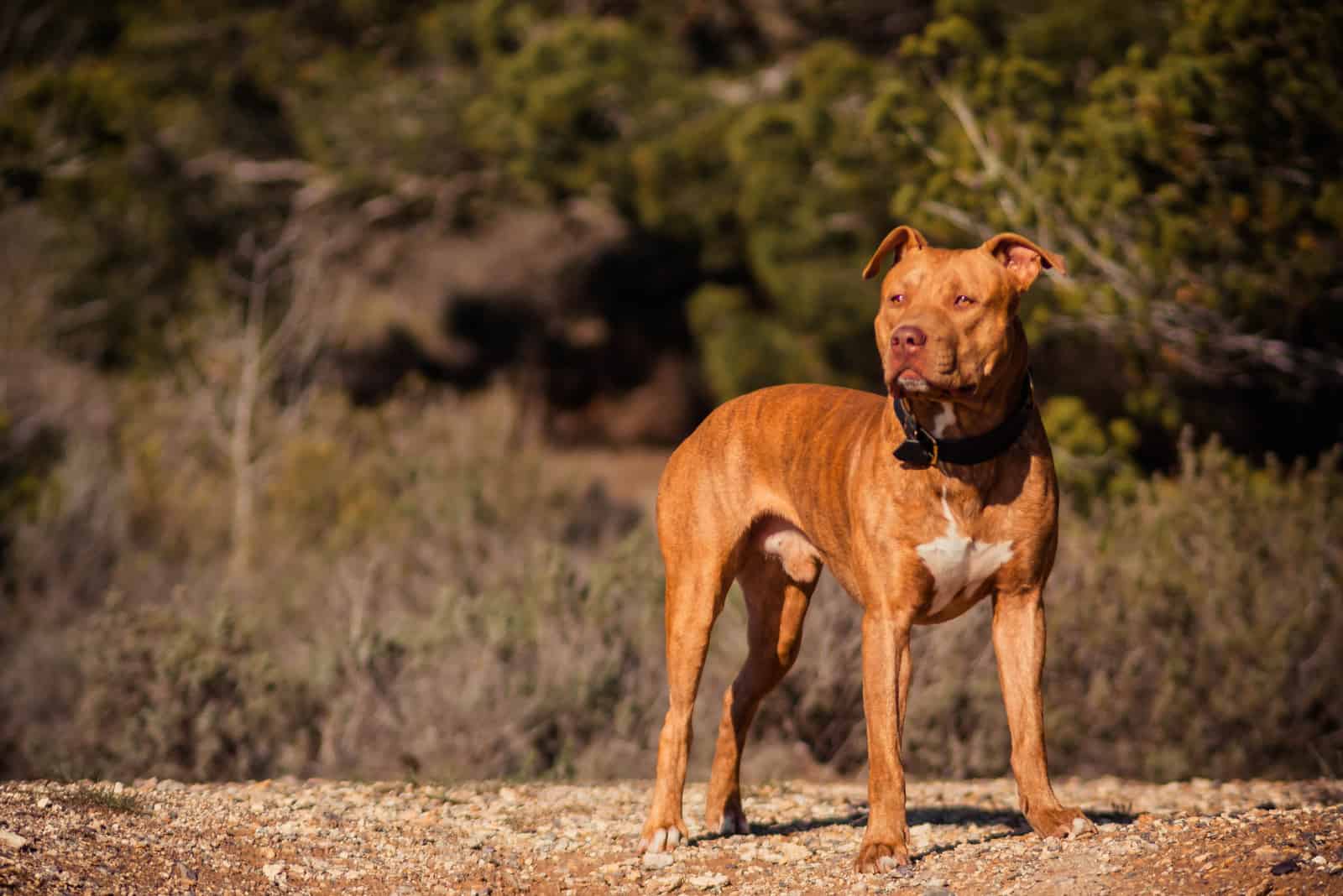
Some Pitbull colors are considered to be standard by both the AKC and UKC. Others are approved by just one of these organizations.
Some, however, are deemed undesirable, no matter the type of dog. This is usually because they’re connected with certain genetic conditions and health problems, or they simply haven’t been studied enough.
Nonetheless, dog owners love all of these colors and combinations, and most are pretty popular.
We’ll go over all the different colors Pitbulls can have.
American Pitbull Terrier Colors Black
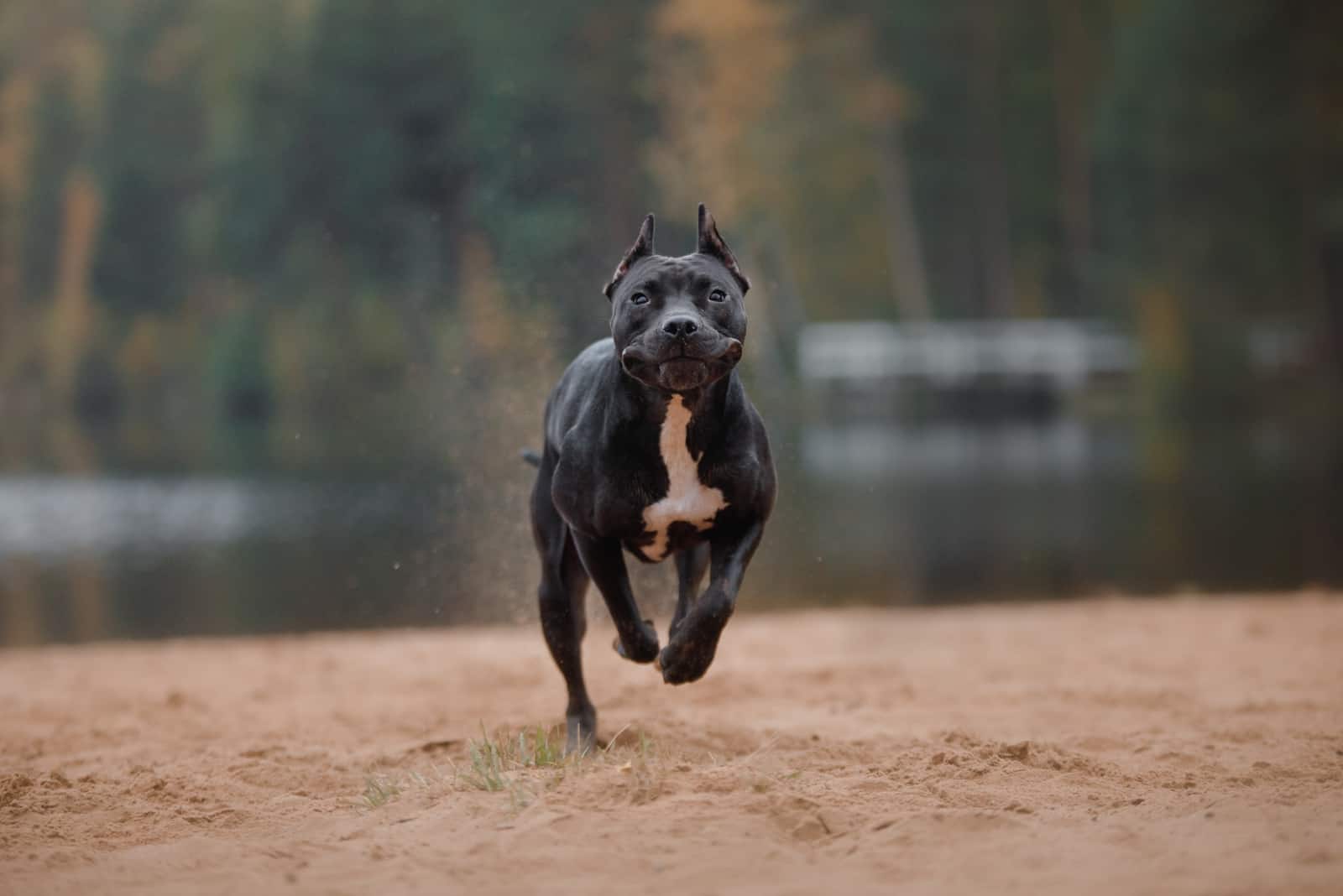
Black
Black is one of the more common Pitbull colors. It’s caused by pheomelanin, one of the two pigments in dogs.
These dogs can come in solid black or, usually, with a small patch of white. This is caused by the dominant black gene, which also causes their nose and eyes to be very dark in color.
While the black recessive gene exists, it’s very rare in Pitbulls as it results from an old mutation. These dogs are always solid black and can’t have any white patches on their coat.
Black Mask
While fairly rare, some Pitbulls have a dark mask around their nose. This type of marking is also known as a melanistic face mask. It can appear on dogs of all shades, except for solid black. Black Pitbulls might carry the black mask genes, but they will remain cryptic.
This mask is indicative of the presence of the black mask allele (Em) located in the E (Extension) locus. This is a dominant allele, so a dog will have a black mask if it has two E locus alleles or a combination of a black mask allele and any other two E locus alleles.
Black And White
Black and white Pitbulls have a coat pattern that varies from a simple white stripe located on their chest to more complex spots. They can even be particolored or have piebald patterns.
While phaeomelanin is dominant in these dogs, they also have eumelanin expressed on the same parts where they have a black coat. The absence of pigment cells causes noticeable white patches.
Unfortunately, black and white Pitbulls were commonly used as fighting dogs, so they have a terrible reputation. However, as we’ve mentioned before, the color pattern doesn’t influence a dog’s personality.
At the same time, since these dogs might come from an aggressive background, socialization from puppyhood is essential for them to make great family pets.
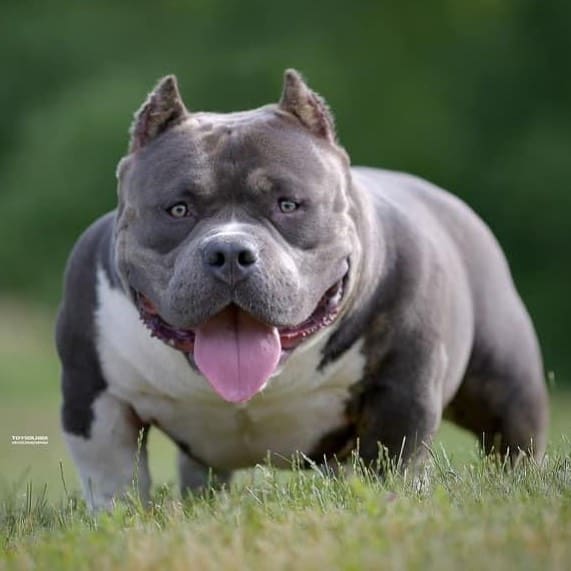
Photo from @30bkennels
Black And Tan
A black and tan Pitbull without white markings is very rare. This is because tan markings are connected to the KY genes, and a dog has to be homozygous for it.
As long as the dog has the KYKY genotype, the presentation of tan markings on a black coat will be determined by the agouti (A) locus.
If the dog has a dominant black gene, it won’t be able to express tan markings. The dominant black is stronger than the A locus, so the tan color allele cannot modify it.
Black Brindle
A black brindle coat color can be very difficult to notice compared to other brindle variants. This is when the tiger stripes that are usually tan-colored stand out over the basic black coat and are darkened by the black.
Still, this is one of the most popular coat colors among Pitbull lovers.
For a dog to be black brindle, it needs to carry the brindle KBR allele and have a black base color.
Piebald Pitbulls
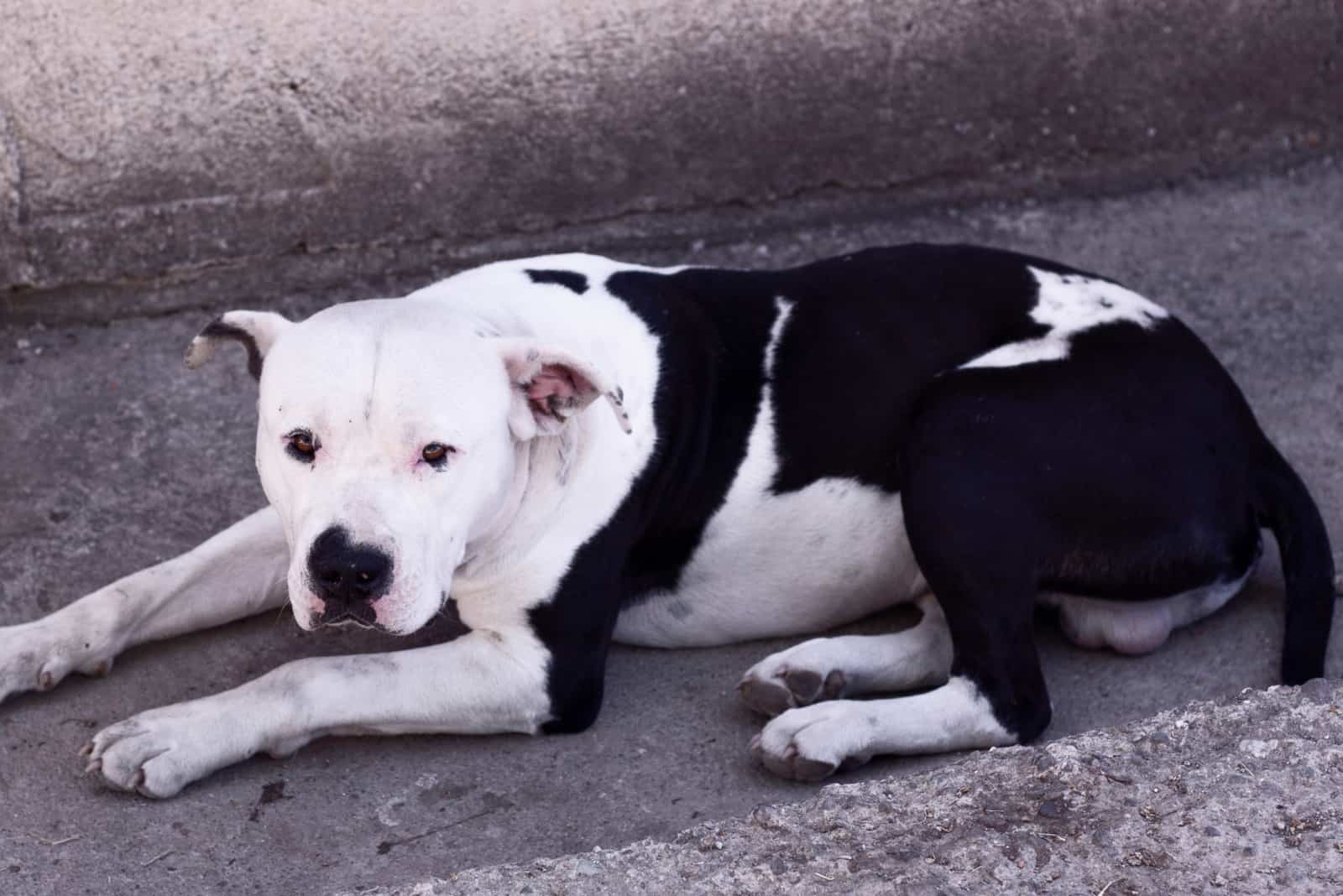
If your dog has white markings that resemble a cow – that’s the piebald pattern. Piebald Pitbulls have unpigmented white markings that intersect pigmented sections. Usually, the color distribution is between 20% and 60%.
The piebald pattern is caused by the S locus or the microphthalmia-associated transcription factor (MITF) gene, the same one that is responsible for the white mask. The only difference is that piebald is determined by the recessive Sp allele.
The pattern itself and the number of white markings depend on the numerous allele variants, so it’s exceptionally rare to find two dogs with the same markings.
Brindle Pitbulls
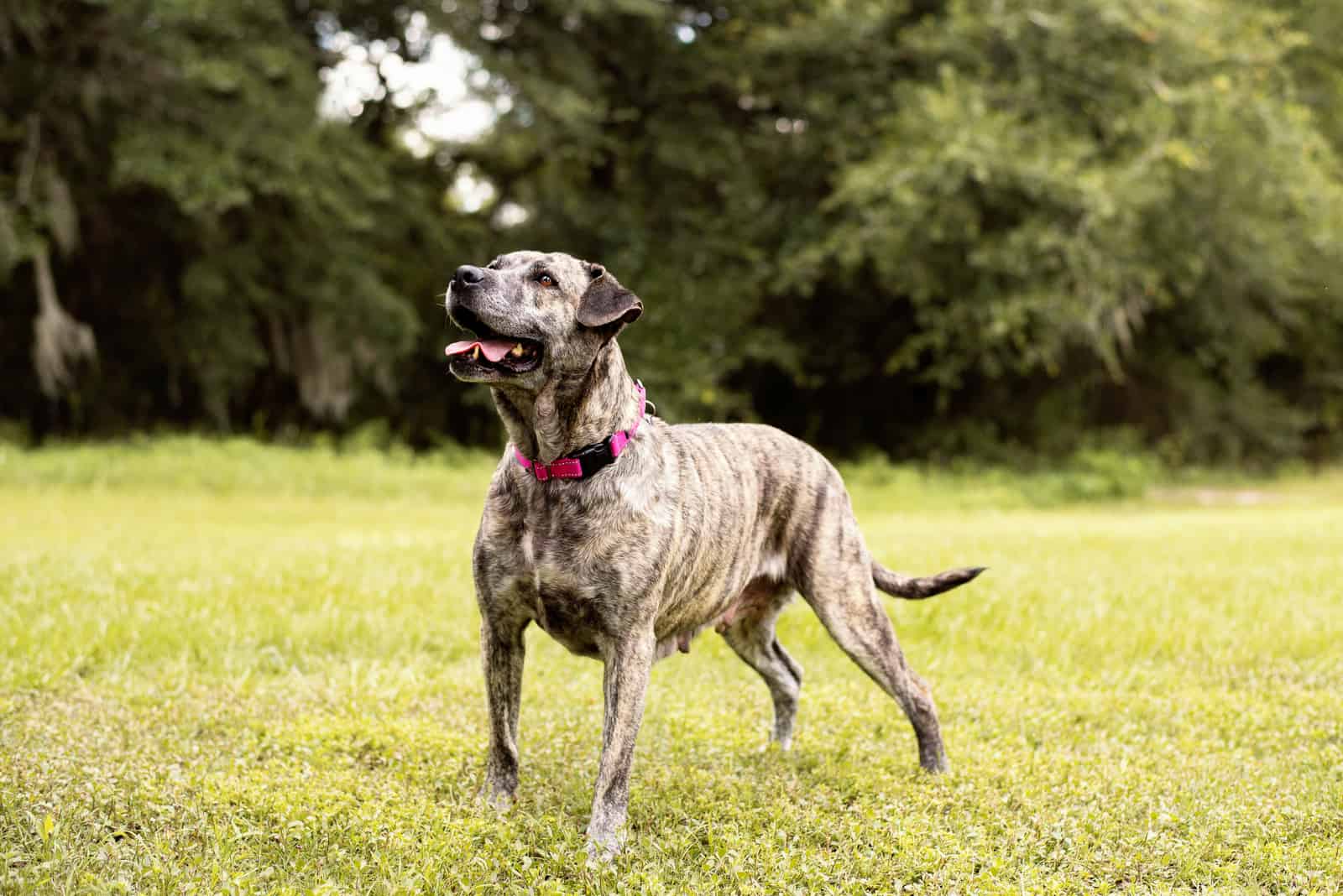
Brindle is among the rare Pitbull colors, as it’s caused by a recessive gene – or rather, by the KBR allele located in the K locus. Since the K locus usually includes a dominant black gene, the brindle allele is usually hidden.
Normally, a brindle Pitbull has to inherit a brindle allele from both of its parents. However, if you pair this allele with the non-black (KY) allele that can also be found in the K locus, the brindle pattern will dominate – but this dog will now have a unique KBRKY gene.
Sable Pitbulls
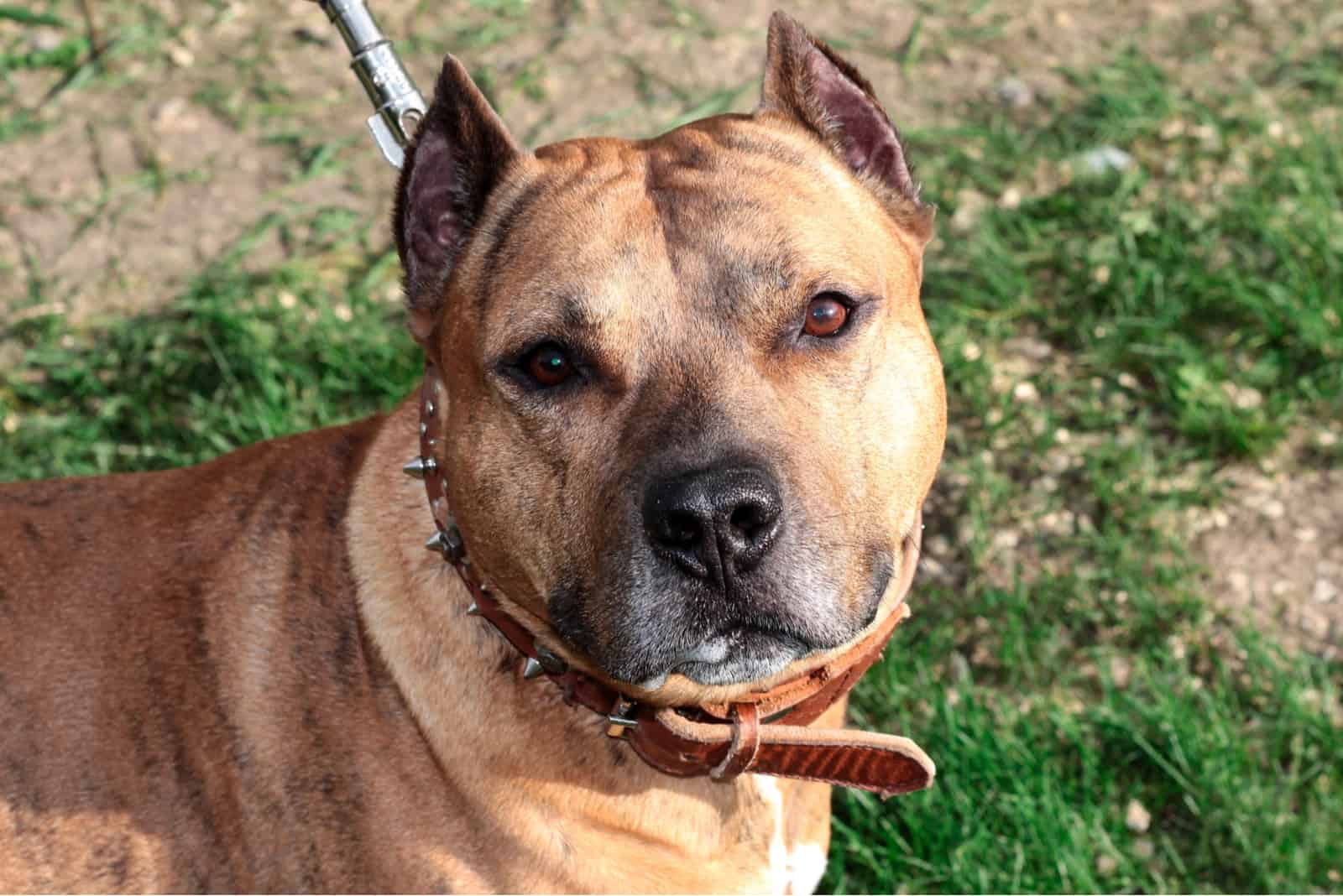
Sable Pitbulls have a fawn or red base color, but it has a black overlay that can be noticed in the black tips of the hair. Sable can be heavier or lighter, depending on the pup’s genetics.
All sable Pitbulls have the recessive sable allele (ay). This allele is one of the four alleles in the agouti (A) locus, or the ASIP gene.
It isn’t uncommon for sable Pitbulls to have a black mask on their face that usually covers their nose (but rarely the eyes).
Fawn Pitbull Colors
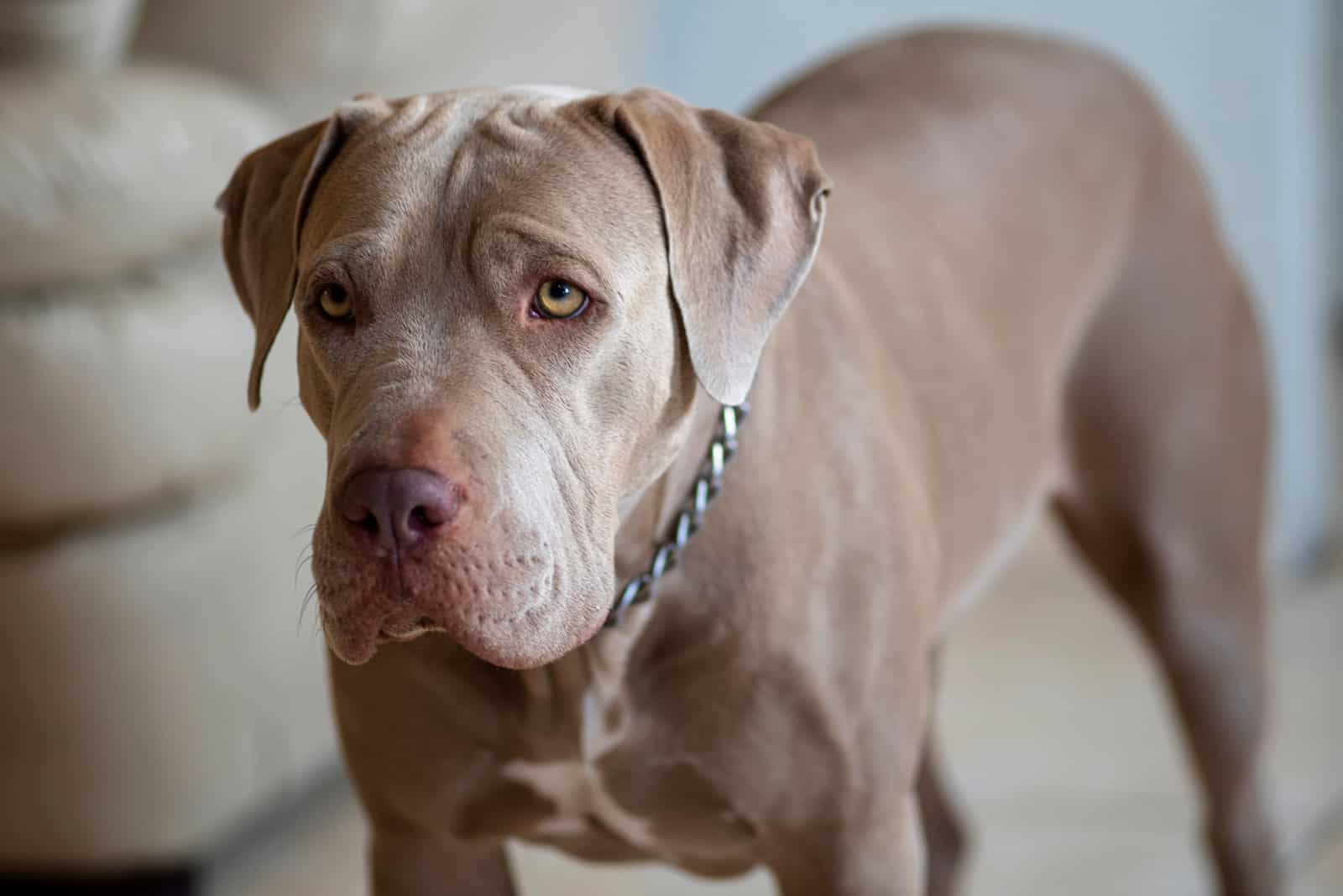
Fawn
Fawn is a common one among Pitbull colors. This shade can vary between a brown-reddish-yellow with a noticeable temperate gold and very light brown without red or gold tones.
In fact, fawn is caused by a diluted K-locus or dominant black gene. While it isn’t certain what gene causes this dilution, two possible culprits are the I-locus that changes the intensity of the color or the Chinchilla dilution (CCH) gene that is a part of the C-locus.
Blue Fawn
This is an extremely rare but nonetheless gorgeous Pitbull color. These pups have a bluish silver base coat with fawn markings and overlays. While some dogs with a fawn coat and blue markings are also advertised as blue fawns, they are, in fact, not true blue fawn Pitbulls.
Once again, the nose of these pups is always blue. Even if it seems black at first glance, if you look at it closely, you’ll notice that it’s, in fact, a very dark blue.
Fawn Brindle
This is one of the brighter brindle Pitbull colors. The stripes are highly visible as they are distributed across a light base color. Compared to black brindle or liver brindle, you can notice fawn brindle from afar!
This is a reasonably rare Pitbull color, but plenty of dog breeders that sell puppies with this pattern exist.
Fawn Sable
This is a rare variation of the standard fawn color. Since sable indicates dark black or dark brown patches, fawn sable Pits have a basic reddish coat color with a black overlay. Depending on the gene interaction, this overlay can be more or less noticeable.
The black can also be seen on a Pitbull’s muzzle and rims of the eyes, sometimes even in the shape of a pure black mask.
Blue Pitbull Colors
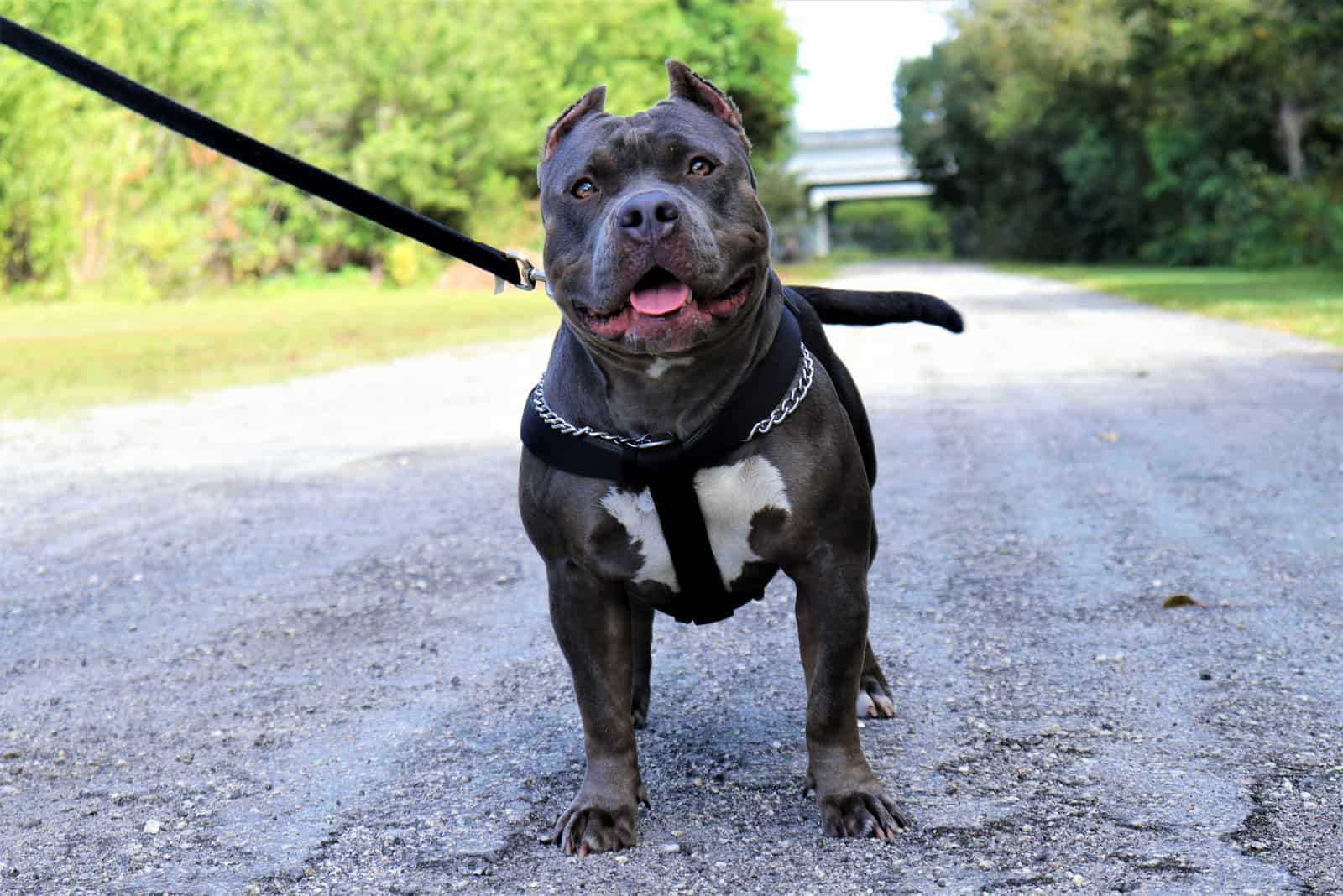
Blue
According to the American Pitbull Registry, blue Pitbull puppies are among the most popular pets when it comes to this dog breed. There is always a high demand for these dogs, even though it’s one of the rarest Pitbull colors.
The blue color is, in fact, a diluted black color that looks like grey. It comes in several shades, from deep blue to a lighter blue. These Pitbulls always have blue noses. Even if the dog appears to have a black nose – it’s actually a blue nose Pitbull.
Blue Mask
The genetics behind this marking is similar to the black mask, as it is also caused by the Em black mask allele in the E locus. However, this time, the Extension locus affects the distribution of the melanin pigment called eumelanin.
The visibility of the blue mask depends on the Pitbull color. For example, a solid blue Pitbull with a fairly dark muzzle usually won’t allow the blue mask to be noticeable.
On the other hand, a blue fawn Pit with just a blue tint and a light fawn color will allow the color to express itself.
Blue And White
Blue and white Pitbulls have blue as their primary coat color, with a white marking from their neck all the way to their chest. Sometimes, the marking can be found on their feet, forehead, and muzzle.
Just as in regular blue Pitbulls, the base coat color is the result of the dilution of the black gene. On the other hand, the white markings are locations on the fur without pigment cells.
Blue Brindle
As their name suggests, blue brindle Pitbulls have a blue base coat that could be either darker or lighter and gold or cream brindle stripes. Depending on the shade of blue, the stripes could be more or less noticeable.
These pups commonly have white patches, usually around their neck and on their chest, muzzle, face, and paws. Also, just like in blue Pitbulls, their noses are always blue and never black.
Brown Pitbull Colors
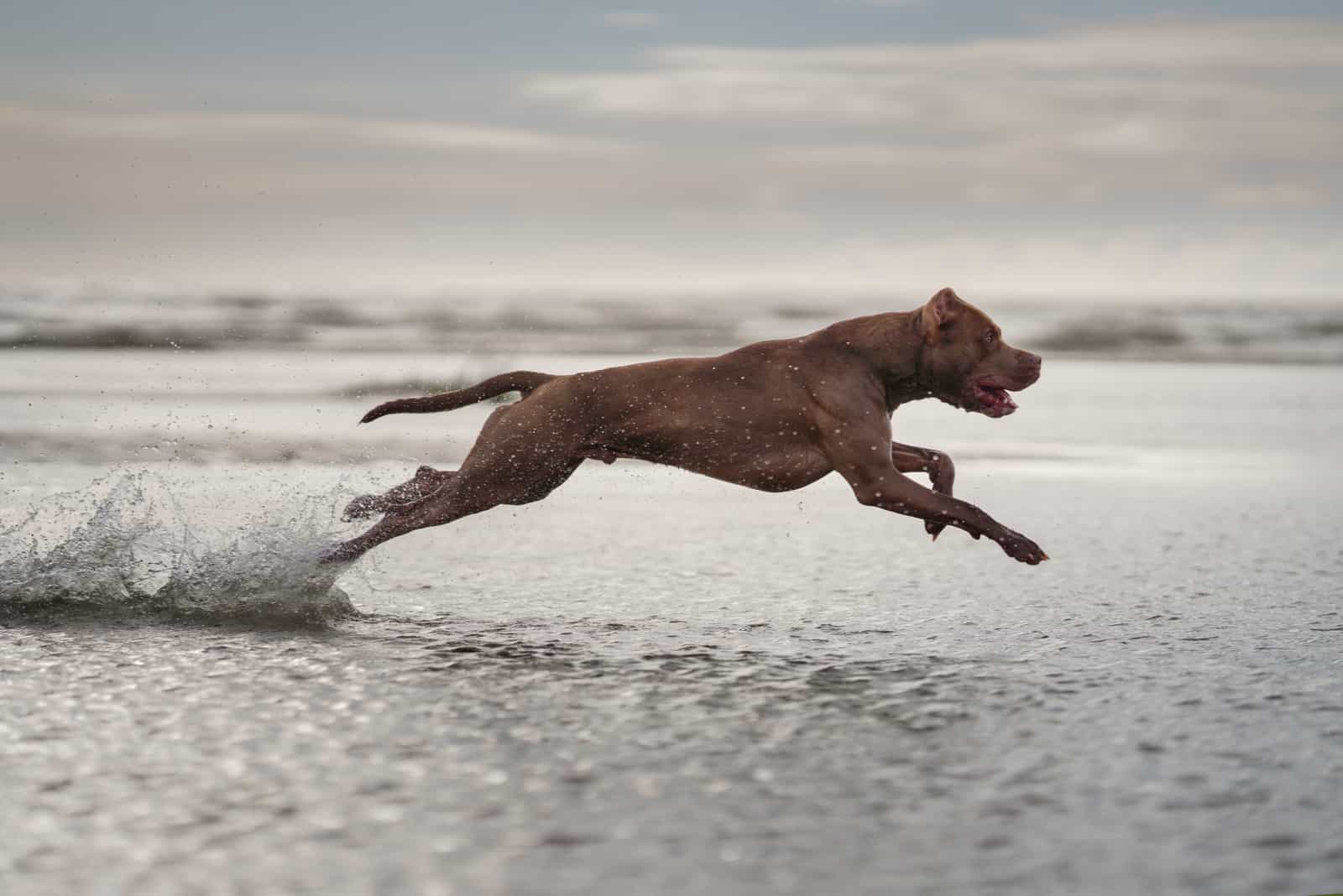
Brown
The brown color in canines is actually a dilution of the dominant black color present in the brown (B) locus. To have this coat, a Pitbull puppy should have two parents with the recessive b allele, so they can have a bb combination that will dilute the black pigment, creating brown.
Depending on the strength of the dilution of the dominant black, the coat can be either brown, liver, or chocolate.
These dogs always have brown rims of the eyes, noses, and paw pads since the dominant black gene is entirely silenced by the bb allele.
Brown And Tan
These Pits have a main brown coat color with tan points on certain spots.
Overall, a Pitbull needs to be homozygous for tan points to be expressed. At the same time, while the recessive black gene is rare, heterozygous dogs with tan and recessive black can also express tan points.
True tan points in brown and tan Pitbulls are always expressed above the eyes, on the lips and lower jaw to the throat, on the cheeks, chest, lower side of the tail, and on the feet all the way to the inner side of all four legs.
Liver
Liver is a variation of the brown coat color. It looks like a very dark brown and is caused by the brown B-locus.
This color is, in fact, a dilution of a black pigment. The dilution gene inhibits the production of eumelanin, keeping it from expressing entirely. This is similar to the case with the blue coat color.
These Pitbulls mostly have liver or brown lips, rims of the eyes, noses, and footpads. In most cases, their eyes are amber or gold instead of dark brown, as is the case with most Pitbull colors.
Brown Brindle
Brown brindle Pits have black tiger stripes over a brown coat color. This makes the brown color appear a bit lighter than it normally would.
Similar to any other brindle, with brown brindle, the stripes of the darker color are irregular and tend to appear more in some parts of the Pitbull ’s coat than others. This is all due to the complex interaction of color genes.
In all brown brindle Pitbulls, there is a black mask covering the muzzle and rims of the dog’s eyes. A white patch on the chest is also common.
Liver Brindle
Despite being rare to most canines, liver brindle is a fairly common Pitbull color pattern. In fact, this might be the most common type of brindle in Pitties.
Liver brindle Pitbulls look just like other brindle Pitbulls, except that their base coat color is white instead of, for example, red or brown.
This coat pattern is somewhat similar to black brindle in the sense that it can be difficult to notice, especially compared to lighter coat colors such as the red brindle.
Unique to this Pitbull color, the nose of these dogs will always be brown or liver-colored.
Seal Brown
At first glance, these Pitties appear to be black. However, when you look at them closely, you’ll notice that the fur looks as if it’s black with a brown or red glow overlay.
This is a very rare Pitbull color, and one that is not entirely understood by experts. Its exact genetics are unknown, but it is believed that the color is the result of a black pigment that doesn’t have complete dominance.
These dogs can have white markings, usually on their neck, chest, paws, and under the tail.
Champagne Pitbull Colors
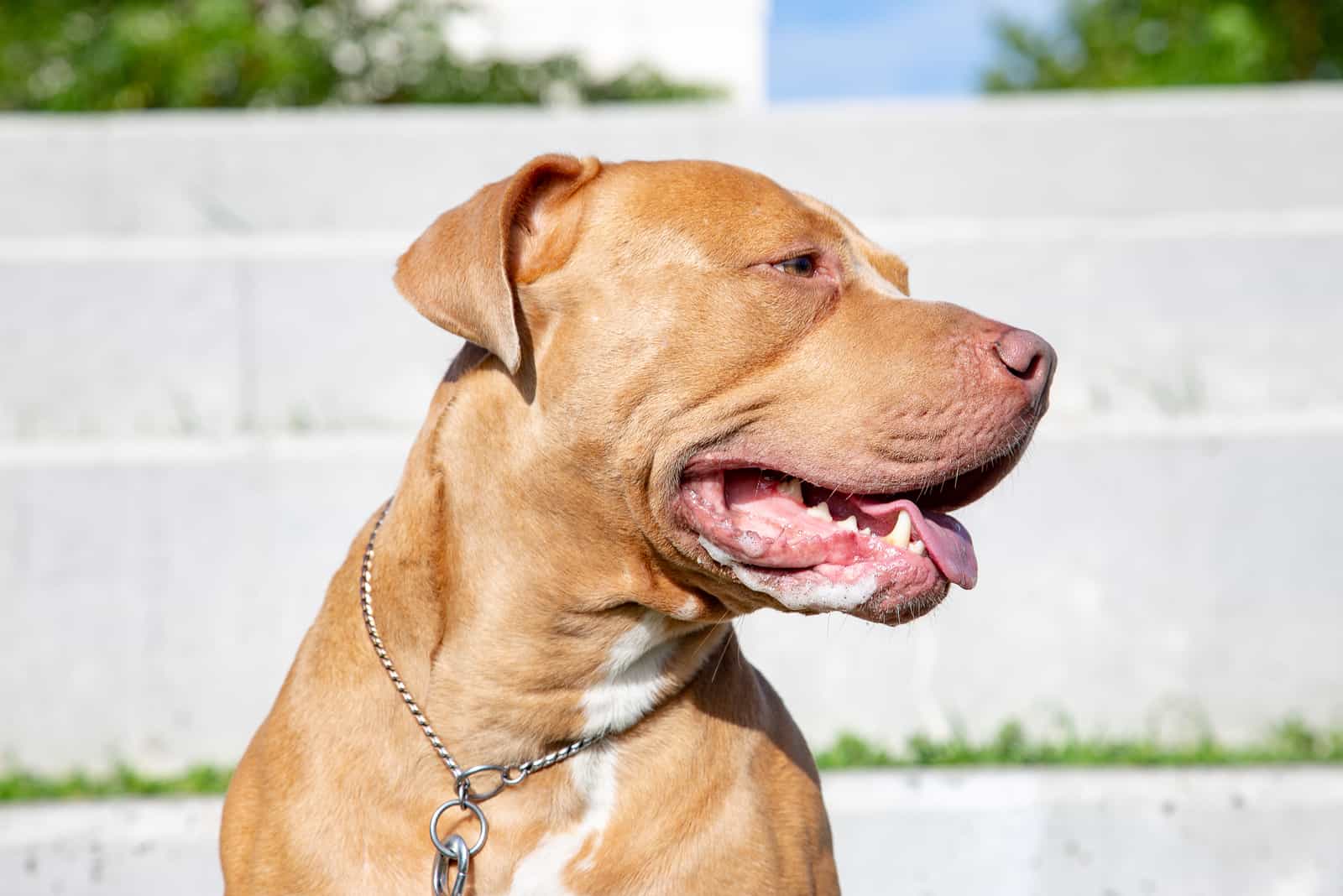
Champagne Pitbulls come in a pale shade of cream or yellow coat that resemblances the popular champagne color. While they might be mistaken for brown Pitbulls due to their liver nose, their coat color is caused by different genetics.
Champagne color is caused by a specific dilution gene that turns the red coat color into this pale, champagne shade.
As such, champagne Pitbulls will never have a black nose – although some might have blue nose, noses, and paw pads. Also, their eyes tend to be amber or even blue.
Blue Champagne
Blue champagne Pitbulls happen when the gene for blue Pitbulls works together with the dilution gene for a champagne color.
These dogs will look just like regular champagne Pitbulls, except their noses, paw pads, eye rims and lips will be a pale shade of blue.
Champagne Brindle
These Pitbulls have a somewhat unique brindle pattern. A typical Brindle Pitbull will have dark stripes that are easily visible.
Champagne brindles, however, cannot have black or even brown stripes. Instead, their markings will be barely visible – but still there.
Champagne And White
White markings are perfectly normal in champagne Pitbulls. In fact, most champagne Pitbulls will have some type of white markings, usually on their chest and paws, but they can cover any part of your doggie’s body.
The only thing that isn’t allowed is if a dog has more than 80% of their body white, as this can be a sign of some genetic health problem.
Red Pitbull Colors
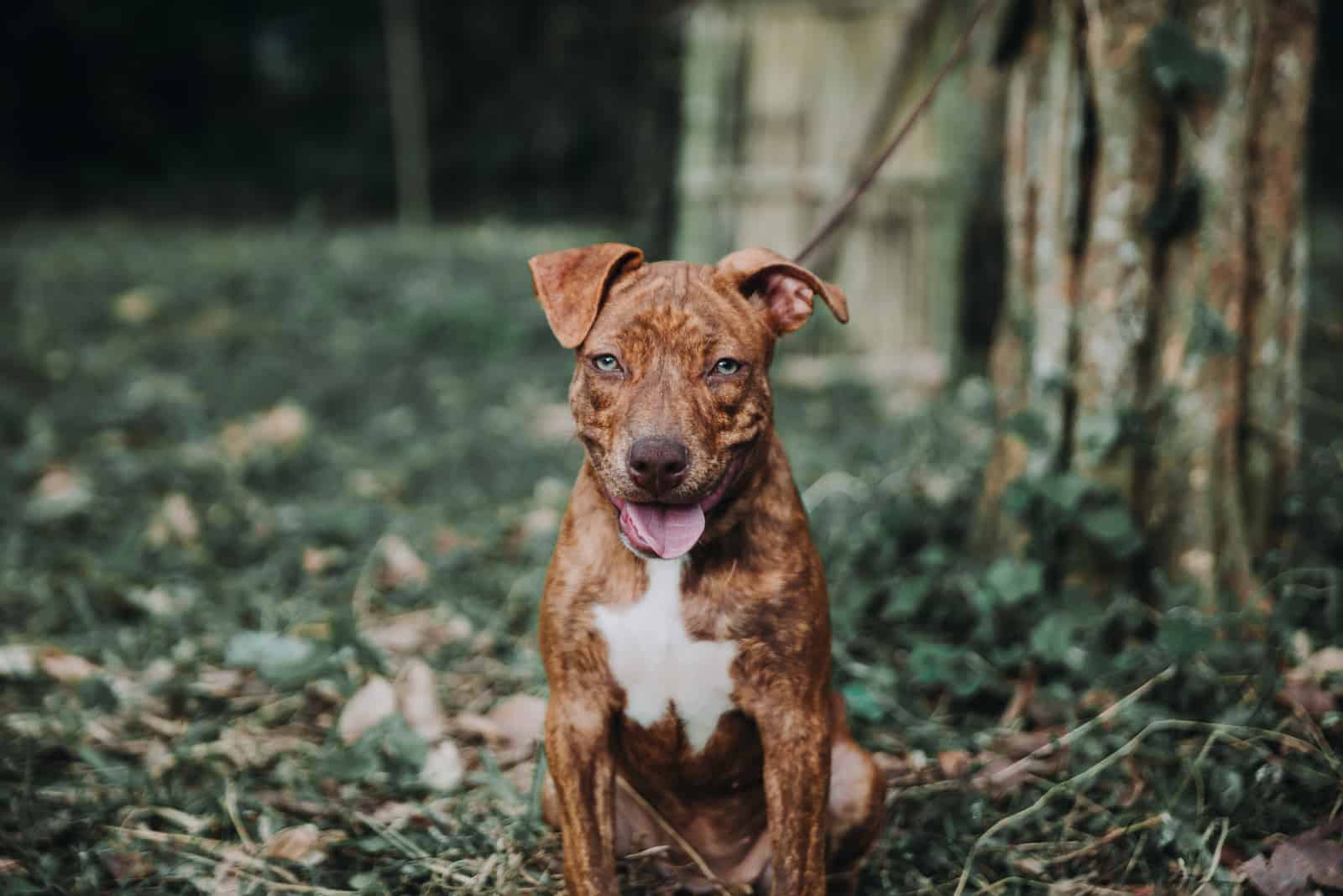
Red
Red is one of the most common coat colors in Pitbulls, but it is also a very popular one. These doggies can come in lighter or darker shades of red, depending on how the pigments react with each other. This coat color is caused by pheomelanin, which is responsible for the red shades in the dog’s fur.
Usually, these dogs have black noses and rims of the eyes, as this is where the eumelanin acts regarding the coat color. However, these dogs can also have brown noses if phaeomelanin is prevalent, although this is rare.
Bronze
This is a rare variation of a red pigment. While not one of the default shades of phaeomelanin, other coat color genes change the intensification of the red, creating shades such as bronze, buckskin, or yellow.
These Pitbulls usually have brown rims of the eyes and muzzles instead of black.
Red Brindle
Red brindle is considered one of the more beautiful Pitbull colors. These dogs have dark stripes that resemble a tiger pattern over the basic dog coat color – which is, as the pattern name indicates, red.
This pattern is caused by the recessive allele in the dominant black (K-locus) gene.
Red Sable
Just like other sable dogs, the black tips of the hairs are caused by the ay genotype. Since these dogs don’t have the dominant black K-locus allele, they have a lighter – in this case, red – base color.
The interaction between the genes determines how much black a red sable Pitbull will have on its coat. This is why there are several shades of red sable Pitbulls.
White Pitbull Colors
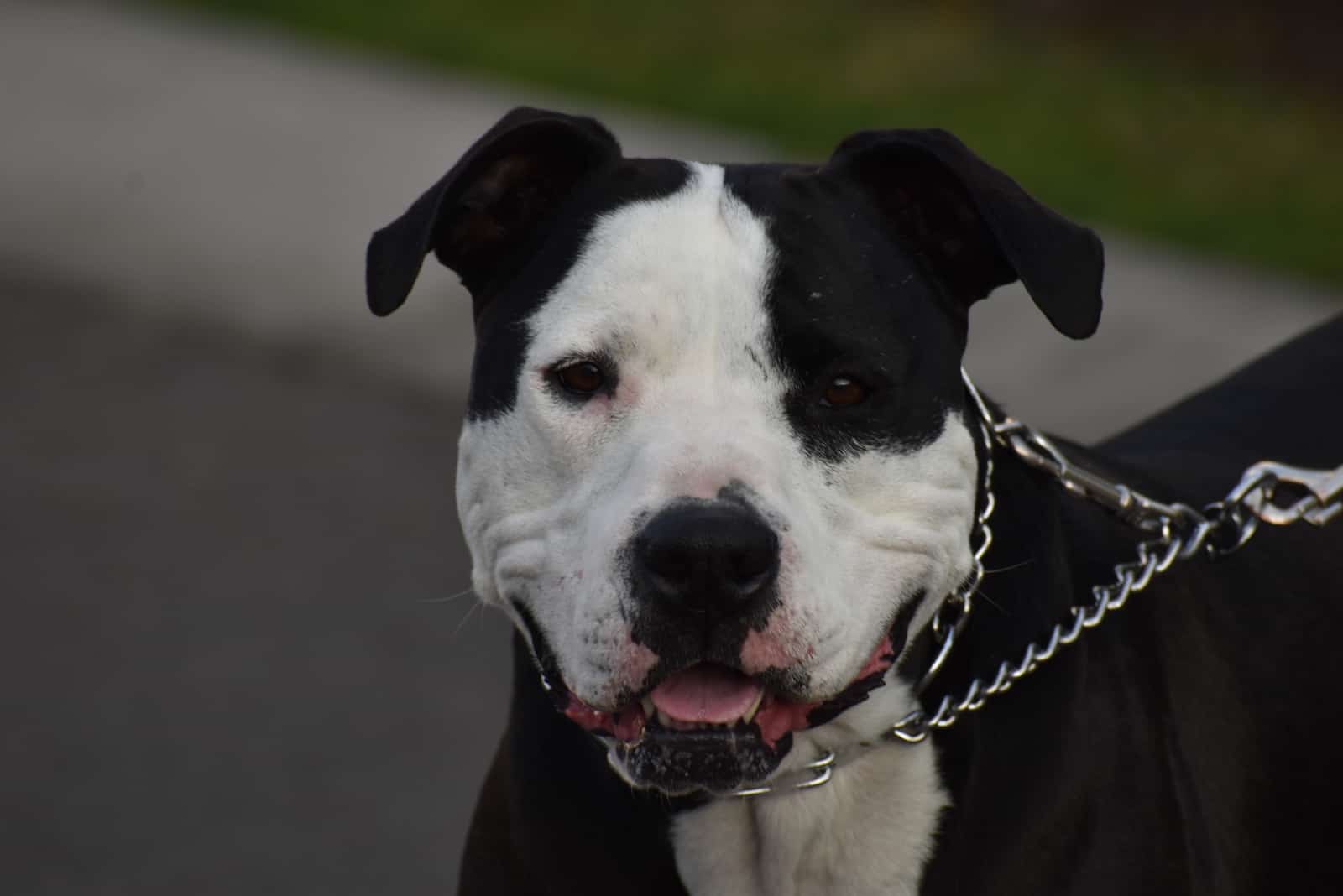
White Mask
Opposite of the black and the blue mask, a white mask needs to be on a darker background to be visible. This is even the case if a dog has the black mask gene.
The white mask in Pits is caused by the white spotting gene (S locus) – or rather, the extreme spotting allele (Sw). This allele indicates the complete absence of pigmentation on a dog’s muzzle and around its nose.
Sometimes, a white mask might extend to the Pitbull ’s eyes. It isn’t rare that only one eye is surrounded by white, while the other keeps its standard color.
White
Pure white Pitbulls are also among the rare Pitbull colors. This color is the result of missing melanocytes, the cells responsible for the pigmentation of the dog’s skin and coat.
These dogs are called Extreme White, and they are labeled with the Sw allele in the S locus.
Regular white Pitbulls will still have a dark nose and the usual dark eyes – although this isn’t mandatory. However, if a red nose Pitbull has blue or red/pink eyes, he suffers from albinism.
Albino Pitbulls suffer from a wide range of genetic defects, most notably deafness.
Read Also: 5 Excellent Red Nose Pitbull Breeders From The USA (2022)!
Solid Color Pitbulls
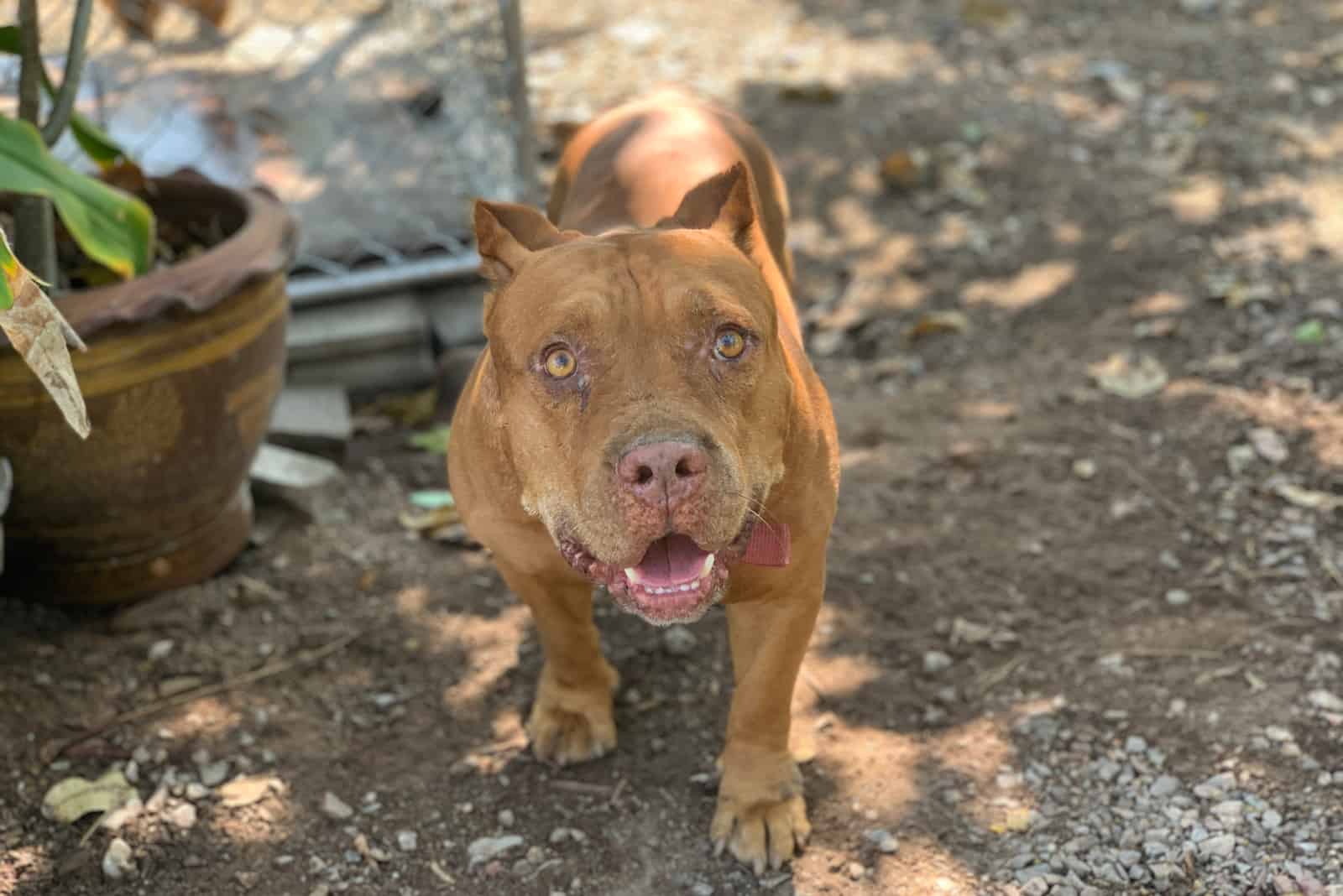
These Pits have a full body of just one color. Solid color Pitbulls are somewhat rare, as most have at least some type of white markings.
This color pattern (or rather, the lack of it) is entirely determined by the dog’s gene pool. Its color depends on the presence of eumelanin or pheomelanin and how they are represented on the coat.
When it comes to solid-colored Pitbulls, the genes cause the body to produce only one pigment throughout the skin. These Pits come in black, brown, blue, fawn, red, and tan.
Merle Pitbull Colors
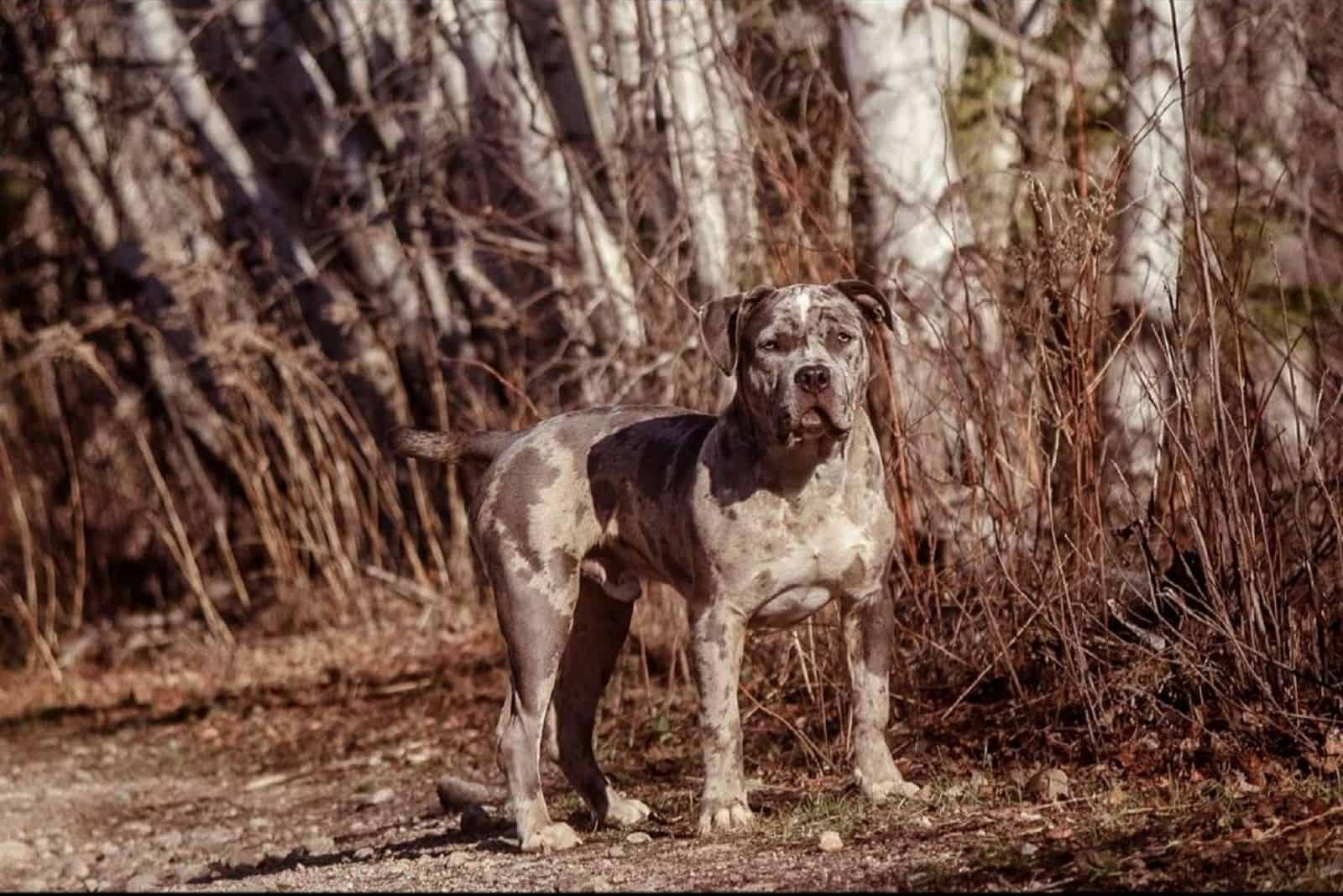
The merle coat color is caused by the dilution gene – a dominant merle allele in the M locus. This gene lightens (or dilutes) solid-colored parts of the dog’s coat into patches of a lighter color. Usually, it dilutes black into gray or white, but it can also dilute red and brown.
In other words, you can have blue merle Pitbulls, red merle Pitbulls, and so on, depending on the most dominant color on their coat.
This pattern can have several variations depending on if the dog is heterozygous (Mm) or homozygous (MM) for this gene. Also, merle Pitbulls usually have blue eyes or heterochromia, where one eye or a part of the eye is blue.
Unfortunately, the merle gene, especially double merles, is connected with a plethora of health problems – but more on this later on.
Spotted
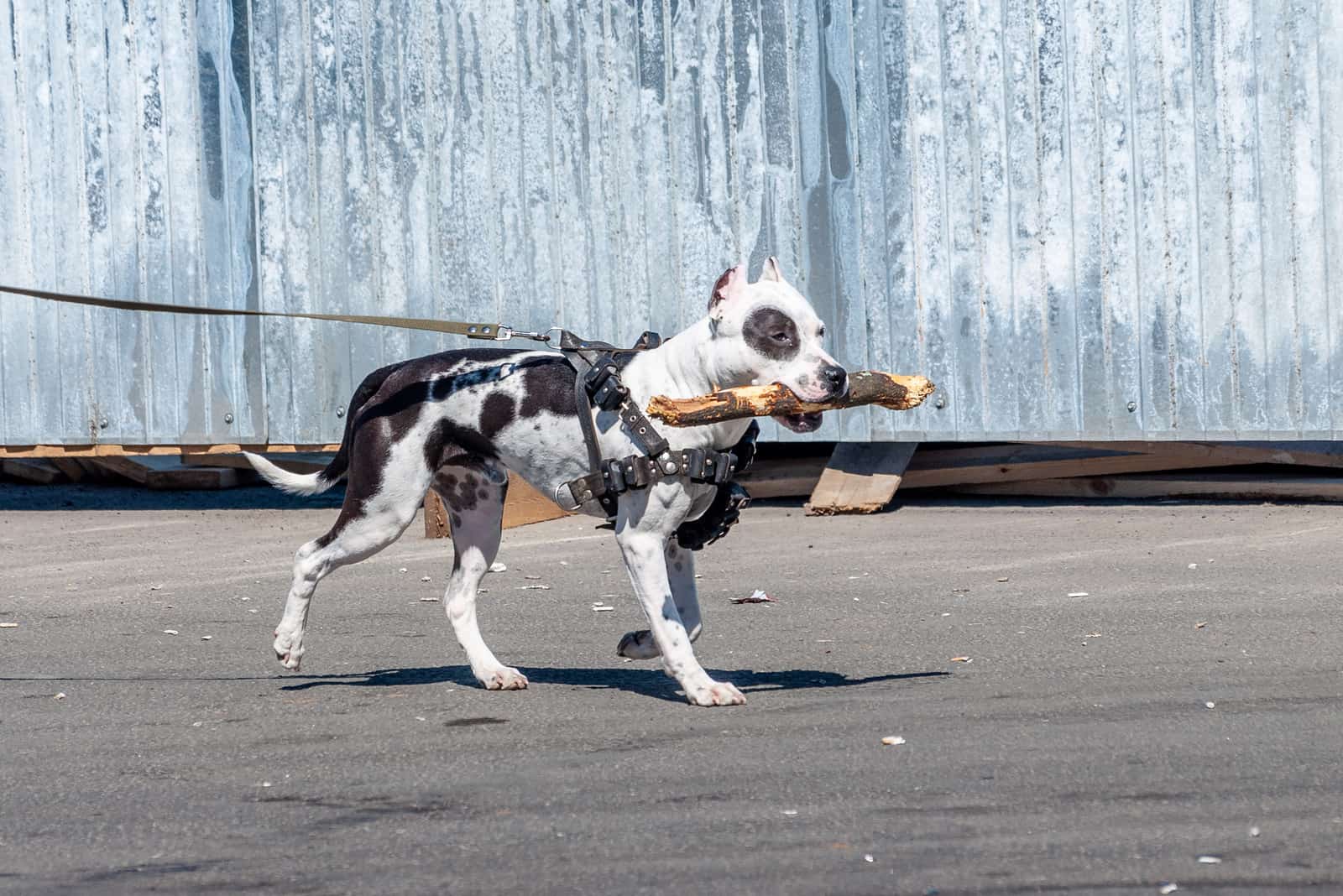
Spotted Pitbulls have irregular white spots. Think of this pattern as that of an inverted Dalmatian. They are rare, so many dog lovers confuse them with merle Pitbull dogs. However, spotted Pitties have smaller spots over their entire body, while merle Pits have spots on different parts of their coats.
This pattern is caused by the MITF, or rather the S locus, which causes irregular patches and spots on a canine’s body.
Tan Points
Tan points in Pitbulls are usually present on the dog’s legs and paws, chest, neck, above the eyes, on the muzzle, cheeks, and underside of the ears. Their shade can vary anywhere from dark red to light cream.
This pattern is usually found on dogs with black or diluted black coats, including blue and brown. It’s also common with tri-colored Pitbulls, in which case the third color is white.
Tri-Colored Pitbull
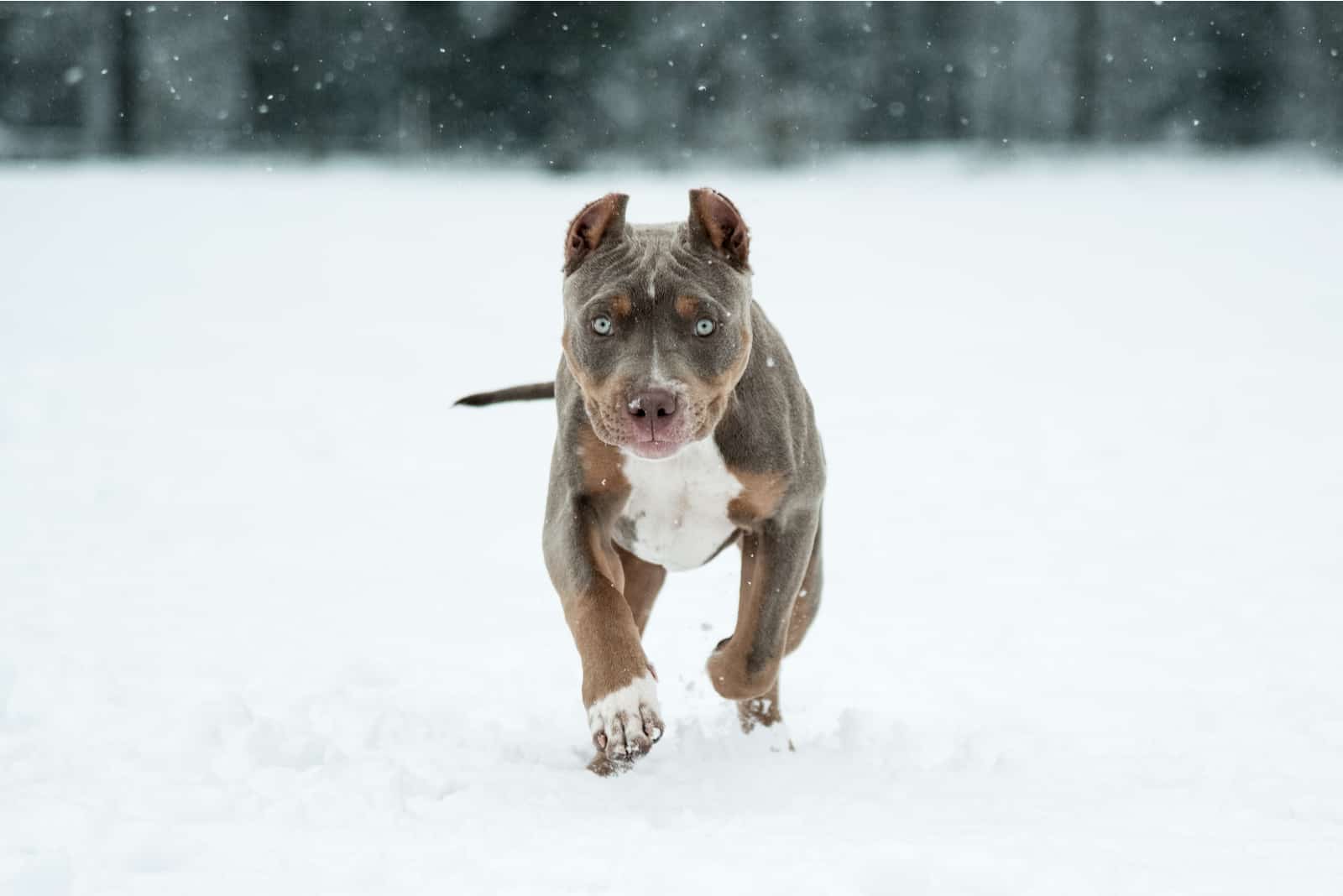
Tri-colored Pitbulls are some of the most popular Pitbull types out there. They have three colors on their coat, so they look quite unique and elegant.
Usually, these three colors are black, white, and tan, as we mentioned when we talked about tan points. However, tricolor Pitbulls can come in almost any color combination – for example, blue, white, and tan.
This is a somewhat rare color combination because it wasn’t popular in the past, so breeders weren’t focused on creating it. As these pups are becoming more sought-after, more and more breeders are reproducing them.
Overall, tri-colored Pits are caused by the recessive (at) allele in the agouti (A) Locus. Depending on the combination (at/a or at/at), they can also yield a black or tan phenotype.
Brindle Points
We’ve already explained brindle. Pitbulls with brindle points mean a brindle dog has patched areas on various locations on its coat. Usually, the brindle pattern will appear in dark patches on a Pitbull’s coat.
This is because the brindle KBR gene is dominant on the A locus, meaning this is where the pattern will express itself. Also, a Pitbull with one or two KBR alleles will further express the genes at the A (Agouti) locus, so the exact pattern depends on this gene.
Why Are Some Unique Rare Pitbull Colors Considered Faulty?
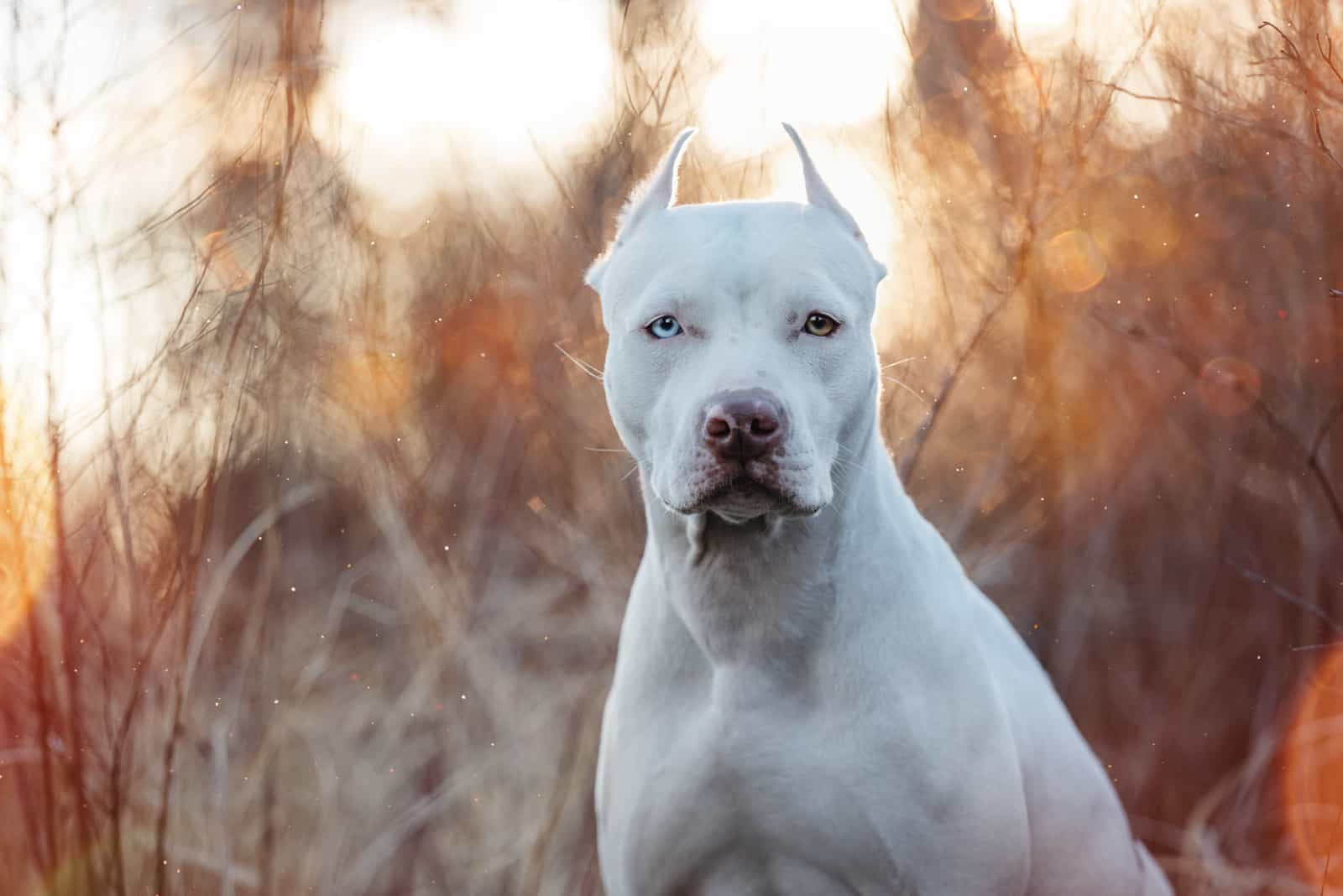
As you can see, there are many different Pitbull colors. However, not all are accepted by the AKC, FCI, or the UKC. These ‘faulty’ colors include:
• Black and tan
• Liver
• Liver brindle
• Merle
• White
• Albino
These colors are associated with an increased chance of a dog developing certain genetic disorders, usually concerning their bones, heart, hearing, or sight. White/albino and merle dogs are especially prone to this.
Pitbulls are already prone to several health problems, such as hip dysplasia, allergies, thyroid disease, and cancer. The chances of dogs developing these issues only increase when they have certain genes that are responsible for these colors.
The merle gene is well-known for creating a lot of health concerns in these dogs. Double merle dogs will almost certainly develop hearing issues, including deafness.
Albinism also causes plenty of skin problems for these dogs, including an increased risk of cancer.
Is Black Dog Syndrome Real?
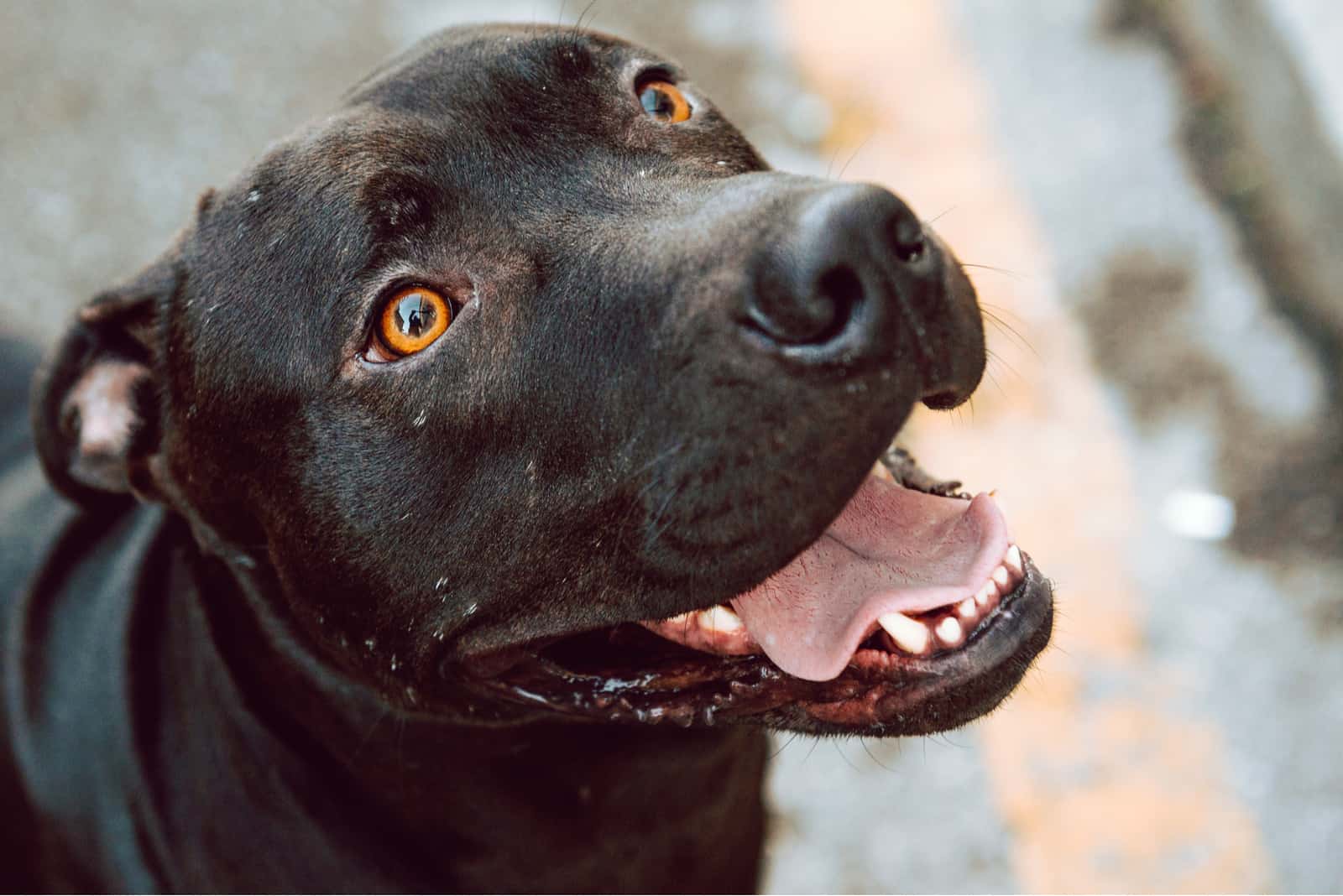
Black dog syndrome is a phenomenon that indicates that black canines are ignored during the adoption process and that dogs of other colors are more likely to be adopted than black dogs.
For Pitbulls, which are labeled as aggressive dogs, this is just another issue that leads to a huge number of these dogs being left at the shelter to be euthanized.
No matter the coat color, whether that be black, white, brindle, or tri-colored, these dogs can make amazing family pets if only given a chance.
Don’t overlook a dog just because of its coat color. All Pitbull colors are beautiful, and with proper socialization, you can have a fantastic and cuddly pet.
Also, while there are many differences between the male and female Pitbull, coat colors are not among them. So go and find a dog that you’ll like!
Read Next: Chesapeake Bay Retriever Colors – What Shades Do They Come In?
